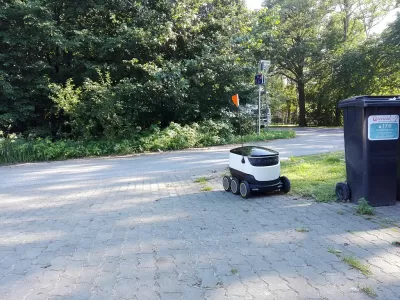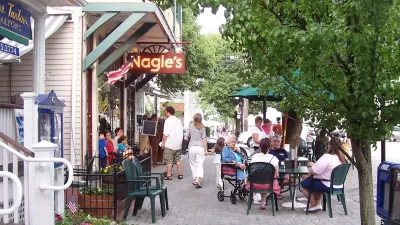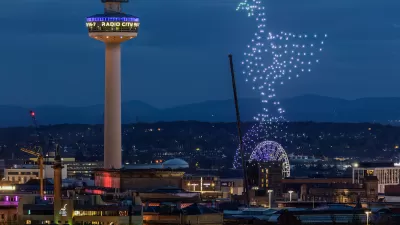A delivery drone pilot launched in Washington, D.C. in 2016 has been expanded for further deployment.

"The D.C. Council has passed legislation to permit the large-scale deployment of delivery robots across the city," reports Sara Gilgore.
According to Gilgore, the law was drafted by and for Starship Technologies, a company that has piloted the robots in D.C. since 2016.
The law removes geographic limitations, meaning Starship could seek permits to operate beyond just four ZIP codes, and enter the previously restricted central business district. It would also allow the company to have more than five robots on the streets at a time (which, as those of us familiar know, could mean more barking dogs and curious pedestrians who encounter them).
Expect to see more delivery robots on the streets and sidewalks of D.C. starting this fall. The company partners with DoorDash and Postmates, and also operated in Virginia, Idaho Wisconsin, Florida, Ohio, Utah, and several cities in California. Delivery robots are coming soon to Arizona too.
The expansion of Starship's service comes despite reports of drivers striking delivery robots with cars, as detailed in an article by Jeff Clabaugh from February 2018.
Hat tip to Chris Teale for sharing the news.
FULL STORY: More robots in D.C.? Here’s what this delivery company is planning.

Alabama: Trump Terminates Settlements for Black Communities Harmed By Raw Sewage
Trump deemed the landmark civil rights agreement “illegal DEI and environmental justice policy.”

Study: Maui’s Plan to Convert Vacation Rentals to Long-Term Housing Could Cause Nearly $1 Billion Economic Loss
The plan would reduce visitor accommodation by 25% resulting in 1,900 jobs lost.

Why Should We Subsidize Public Transportation?
Many public transit agencies face financial stress due to rising costs, declining fare revenue, and declining subsidies. Transit advocates must provide a strong business case for increasing public transit funding.

Paris Bike Boom Leads to Steep Drop in Air Pollution
The French city’s air quality has improved dramatically in the past 20 years, coinciding with a growth in cycling.

Why Housing Costs More to Build in California Than in Texas
Hard costs like labor and materials combined with ‘soft’ costs such as permitting make building in the San Francisco Bay Area almost three times as costly as in Texas cities.

San Diego County Sees a Rise in Urban Coyotes
San Diego County experiences a rise in urban coyotes, as sightings become prevalent throughout its urban neighbourhoods and surrounding areas.
Urban Design for Planners 1: Software Tools
This six-course series explores essential urban design concepts using open source software and equips planners with the tools they need to participate fully in the urban design process.
Planning for Universal Design
Learn the tools for implementing Universal Design in planning regulations.
Smith Gee Studio
Alamo Area Metropolitan Planning Organization
City of Santa Clarita
Institute for Housing and Urban Development Studies (IHS)
City of Grandview
Harvard GSD Executive Education
Toledo-Lucas County Plan Commissions
Salt Lake City
NYU Wagner Graduate School of Public Service





























